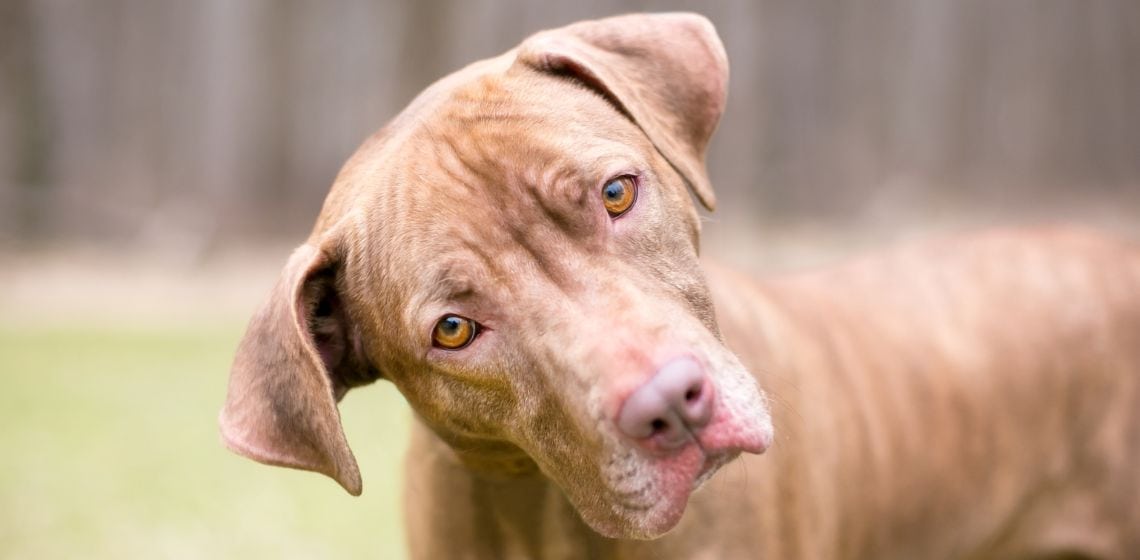Table of Contents
What is vestibular disease in dogs?
The vestibular system is responsible for one’s balance. Vestibular illness can result from abnormalities in the middle and/or inner ear (peripheral vestibular disease) or brainstem (central nervous system), where the cranial nerve that regulates vestibular function emerges. Together, the vestibular nerve and middle and inner ear control a dog’s sense of balance and sense of one’s surroundings. This system helps your dog know where the body is in space. Signs a dog shows with vestibular disease relate to the underlying cause and severity of the damage.
Vestibular disease can be broken down into two forms, peripheral and central. Peripheral vestibular disease generally carries a better prognosis because it doesn’t directly affect the brain.
Peripheral disease
Peripheral refers to areas outside of the brain. This involves diseases that impact the middle and inner ear. Generally, these dogs are still fully with-it mentally, though they may not act like themselves. An example would be a middle or inner ear infection.
Central disease
Central vestibular disease refers to conditions affecting the balance apparatus within the brain. Examples of central disease would include a tumor or infection (encephalitis, meningitis).
Signs of canine vestibular disease
Have you ever been seasick? If so, think about how you felt. Seasickness occurs secondary to effects on your balance system (vestibular system). You may have an upset stomach, feel dizzy, be off balance, almost feel drunk, or have difficulty walking. The same thing is occurring here. The severity of signs will vary depending on the underlying cause. Additionally, variable symptoms arise if it is a central or peripheral disease, underlying conditions, and other factors. You may see any of the following:
- Head tilt,
- Circling (one direction or either),
- Signs suggestive of an external ear infection (otitis externa) – such as head shaking, scratching at the ear, ear discharge,
- Nausea (lip licking, swallowing a lot, not wanting to eat, drooling),
- Vomiting,
- Decreased appetite,
- Abnormal (involuntary) eye movements (nystagmus) – the eyes may rock back and forth (horizontal), roll up and down (vertical) or go around in a circular (rotary),
- Abnormal eye position,
- Droopy eyelids or lips and loss of sensation of the face may occur (facial paralysis; horner’s syndrome),
- Hearing loss,
- Vestibular ataxia – This refers to a characteristic wobbliness, a loss of equilibrium when walking, but without a loss of weakness or muscle spasms (drunk-like walking),
A pet may start with signs, as listed above, with peripheral or central vestibular disease. However, symptoms may progress when the brain is involved (central), and we can see further changes. Signs including abnormal behaviors, abnormal mentation, loss of consciousness, depression, agitation, and even death can occur.
Compare this to peripheral disease, where animals may be sleepy or not themselves but are still alert and interactive.
What are the causes of vestibular disease?
Several things cause vestibular disease, likely including things we have yet to identify. Causes may include
- Otitis (ear infections) – This can include infections of the middle or inner ear (otitis media or interna). The disease can be in one or both ears, and some dogs may have an inner ear infection without an external one,
- Infection or inflammation in the brain,
- Cancer (tumors),
- Medications – some drugs are toxic to the ear drum (tympanum),
- Trauma,
- Hypothyroidism (low thyroid levels) (rare cause),
- Congenital (genetic) defects (rare),
- Stroke (vascular accident) – much less common in animals vs. people.
Your dog may ultimately be diagnosed with idiopathic vestibular disease. We commonly see idiopathic disease in older dogs and often refer to it as ‘old dog vestibular disease.’ Idiopathic means we haven’t identified the underlying cause despite having ruled out all other causes. Dogs with idiopathic illness often get better on their own or with minimal medical management. Overall, idiopathic vestibular disease is pretty common in dogs. Generally, the prognosis is good, though some dogs may have reoccurrences as they age.
How is vestibular disease diagnosed?
History and a thorough physical examination by your veterinarian are crucial to help diagnose vestibular disease in your dog. Always ensure your vet evaluates your pet’s ears (inside and out), as inner ear infections frequently are missed. The only way to know is to look and check to see if the eardrum is intact. Additional diagnostics include ruling in or out other possible causes of illness.
Diagnostics may include:
- Inner ear evaluation (awake or sedated),
- Bloodwork – make sure no systemic signs of illness,
- Blood pressure evaluation,
- Ear cytology – The only way to confirm that there is no external ear infection is to take a sample from each ear, stain it and look under the microscope. (Just looking at the ear, one cannot say with 100% certainty that there is no infection),
- Ear culture – if an infection is present, especially if chronic or the pet fails to respond to therapy
- Testing for possible infectious diseases that could cause inflammation in the brain – this may include blood tests or CSF taps (cerebral spinal fluid evaluation),
- X-rays of the chest and abdomen may be performed to evaluate for cancers or underlying disease,
- Skull radiographs may be considered, but dogs often need to be sedated/anesthetized, and advanced imaging such as CT or MRI is often needed.
Treatment for vestibular disease
Treatment for vestibular disease includes treating any underlying condition causing it and supportive care to manage the clinical signs that occur as a result of a disrupted balance system.
- For ear infections with an external component, topical therapy is used.
- For the inner/middle ear components, long-term antibiotic courses (4-6 weeks) are generally used. Many prescribe 2 weeks at a time and recheck to ensure the pet is responding. If the ear drum is still intact, some dogs may need a procedure to flush out the middle ear (myringotomy) under anesthesia to aid in therapy.
- If cancer or other primary brain abnormality is present supportive care or referral to a specialist for surgery or chemotherapy may be warranted.
- For idiopathic vestibular dogs, care is supportive.
What does supportive care mean for a vestibular dog? This includes anti-nausea (anti-seasickness) and anti-vomiting medications such as Dramamine® (meclizine) and Cerenia®. Fluids may be needed either under the skin or in the veins if the pet has stopped eating. Nursing care and physical assistance may be required, such as using a sling or harness to help them get around. Dogs who are very unsteady on their feet or agitated due to this inability to get around may need sedatives or anti-anxiety medications in the short term.
Prognosis
Some dogs will recover from vestibular disease fully, while others may succumb to underlying illness. Still, others may have residual symptoms such as a head tilt or abnormal balance. The good news is that dogs adapt well over time and can still do well, even with some lingering signs.
Generally, if your pet is going to improve, the dog will start to show improvement within about 3 days. The first day or two are generally the worst for them. As their body adapts, signs improve, and they learn to be more stable on their feet with time. Though not every pet will return to normal, some unsteadiness on their feet or a residual head tilt may remain
Ultimately, quality of life over quantity is key for your dog and the human-animal bond. Suppose signs do not improve or worsen over 72 hours. Dogs not recovering from vestibular disease should be re-evaluated asap.
For those with underlying ear infections, prevention of recurrence largely depends on careful, rapid recognition and effective treatment of external ear infections and addressing underlying causes for infection (allergies, breed tendency). Early detection of clinical signs for those with idiopathic vestibular disease may help your pet start supportive therapy before they become too ill. This will provide for a faster recovery and minimize discomfort.
Recovery from vestibular disease
Recovery is possible. Regardless of the cause of vestibular disease, if feasible to treat the underlying cause, we do. Furthermore, we have medications to support your dog as they recuperate. While this disease can be scary, stressful (for both pet and pet parents), and even fatal, many dogs recover. Many dogs never look back, going on to enjoy a fruitful life. However, suppose your pet isn’t improving. In that case, a more serious condition may be the culprit. You should consult your veterinarian at any time if your pet is worsening or no improvement is appreciated.
This answer depends on the underlying cause and how well the dog’s symptoms are controlled. Some can live well for years after diagnosis; others may succumb to the underlying illness or be euthanized because clinical signs are too severe. Quality of life is more important than quantity.
Vestibular attacks happen when enough inflammation, infection, or damage occurs, affecting the pet’s ability to compensate and symptoms result. The trigger generally isn’t known and depends on the underlying cause.
Vestibular disease can be mild and usually self-curing (idiopathic ‘old dog’ vestibular disease), serious, or even life-threatening (brain tumor or infection). Thus, severity depends on the underlying cause, how soon your pet receives medical attention, and how advanced the disease is at the time of diagnosis.

Dr. Tramuta-Drobnis keeps herself busy as a veterinarian and public health professional, a freelancer, writer, and researcher. Receiving her Veterinary Medical Doctor degree (2005) from the University of Pennsylvania and her Master’s in Public Health from the University of Florida, she’s accrued over 17 years of veterinary clinical experience. Her work with small animals and exotics span general practice, emergency, and critical care medicine. She has a passion for One Health, infectious diseases, pain management, veterinary nutrition, and more.








